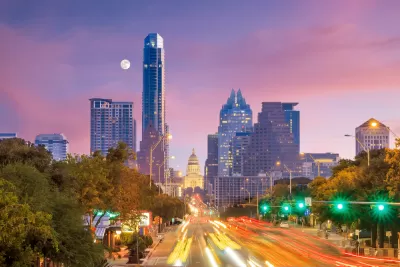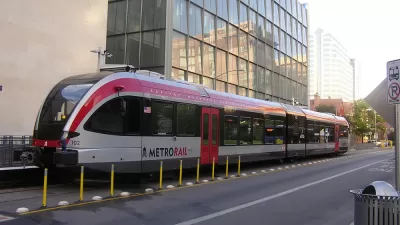Project Connect promises to prioritize equity and inclusion with $300 million dedicated to anti-displacement efforts.

Austin's newly approved $7 billion transit expansion plan boasts an ambitious set of goals that, according to Mayor Steve Adler, meets "so many long-held needs." The project will expand bus and electric bike share services, build a transit tunnel, and install almost ten miles of commuter rail.
While efficient and popular with transportation planners, light rail has a darker connotation for many community activists like Susana Almanza. Almanza, who serves as director of environmental justice organization PODER, worries about the effects of the new transit infrastructure on local communities, citing a history of displacement that frequently follows new rail lines. As transit-adjacency transforms from an undesirable reality to a highly valued urban amenity, low-income communities near rail lines become displaced by luxury housing developments aimed at upwardly mobile workers. An NRDC study of California's major urban areas found that rent for a two-bedroom apartment within a half-mile of a transit stop averaged more than $3,000, well above affordability for most transit-dependent families.
Austin's leaders are addressing these concerns head-on with an equity plan and dedicated budget aimed at helping low-income residents stay in their homes and reducing the negative impacts of rail construction. The budget includes rent subsidies and homeowner assistance to help the communities that rely on transit the most and offset the neighborhood change inevitably brought by new transit infrastructure. As part of the equity plan, the city plans to create a neighborhood-level equity assessment tool and community advisory committee that will monitor performance progress once projects are underway.
FULL STORY: The next challenge for Austin’s transit plan: Delivering on its equity pledge

Alabama: Trump Terminates Settlements for Black Communities Harmed By Raw Sewage
Trump deemed the landmark civil rights agreement “illegal DEI and environmental justice policy.”

Study: Maui’s Plan to Convert Vacation Rentals to Long-Term Housing Could Cause Nearly $1 Billion Economic Loss
The plan would reduce visitor accommodation by 25% resulting in 1,900 jobs lost.

Why Should We Subsidize Public Transportation?
Many public transit agencies face financial stress due to rising costs, declining fare revenue, and declining subsidies. Transit advocates must provide a strong business case for increasing public transit funding.

Paris Bike Boom Leads to Steep Drop in Air Pollution
The French city’s air quality has improved dramatically in the past 20 years, coinciding with a growth in cycling.

Why Housing Costs More to Build in California Than in Texas
Hard costs like labor and materials combined with ‘soft’ costs such as permitting make building in the San Francisco Bay Area almost three times as costly as in Texas cities.

San Diego County Sees a Rise in Urban Coyotes
San Diego County experiences a rise in urban coyotes, as sightings become prevalent throughout its urban neighbourhoods and surrounding areas.
Urban Design for Planners 1: Software Tools
This six-course series explores essential urban design concepts using open source software and equips planners with the tools they need to participate fully in the urban design process.
Planning for Universal Design
Learn the tools for implementing Universal Design in planning regulations.
Smith Gee Studio
Alamo Area Metropolitan Planning Organization
City of Santa Clarita
Institute for Housing and Urban Development Studies (IHS)
City of Grandview
Harvard GSD Executive Education
Toledo-Lucas County Plan Commissions
Salt Lake City
NYU Wagner Graduate School of Public Service





























